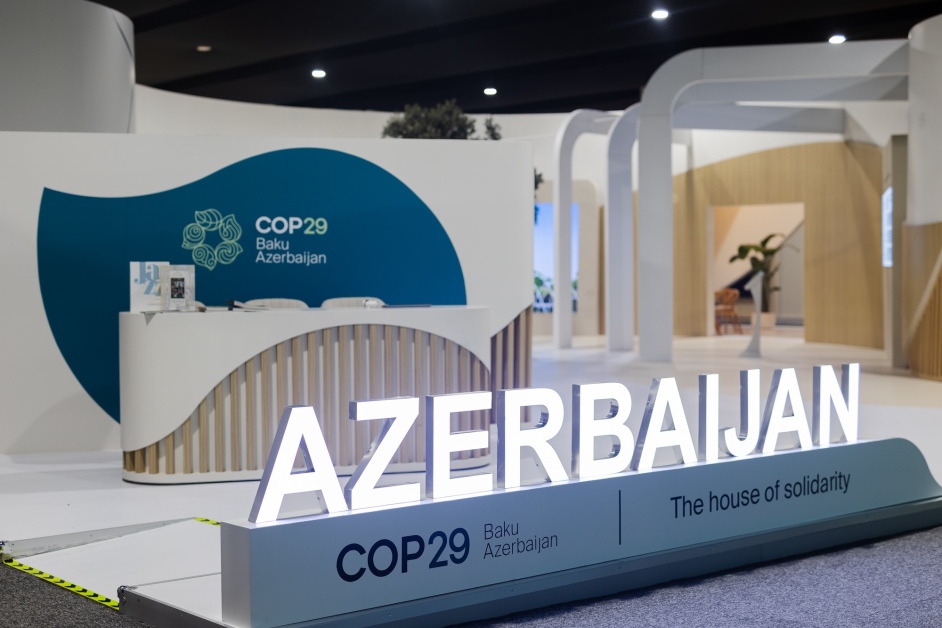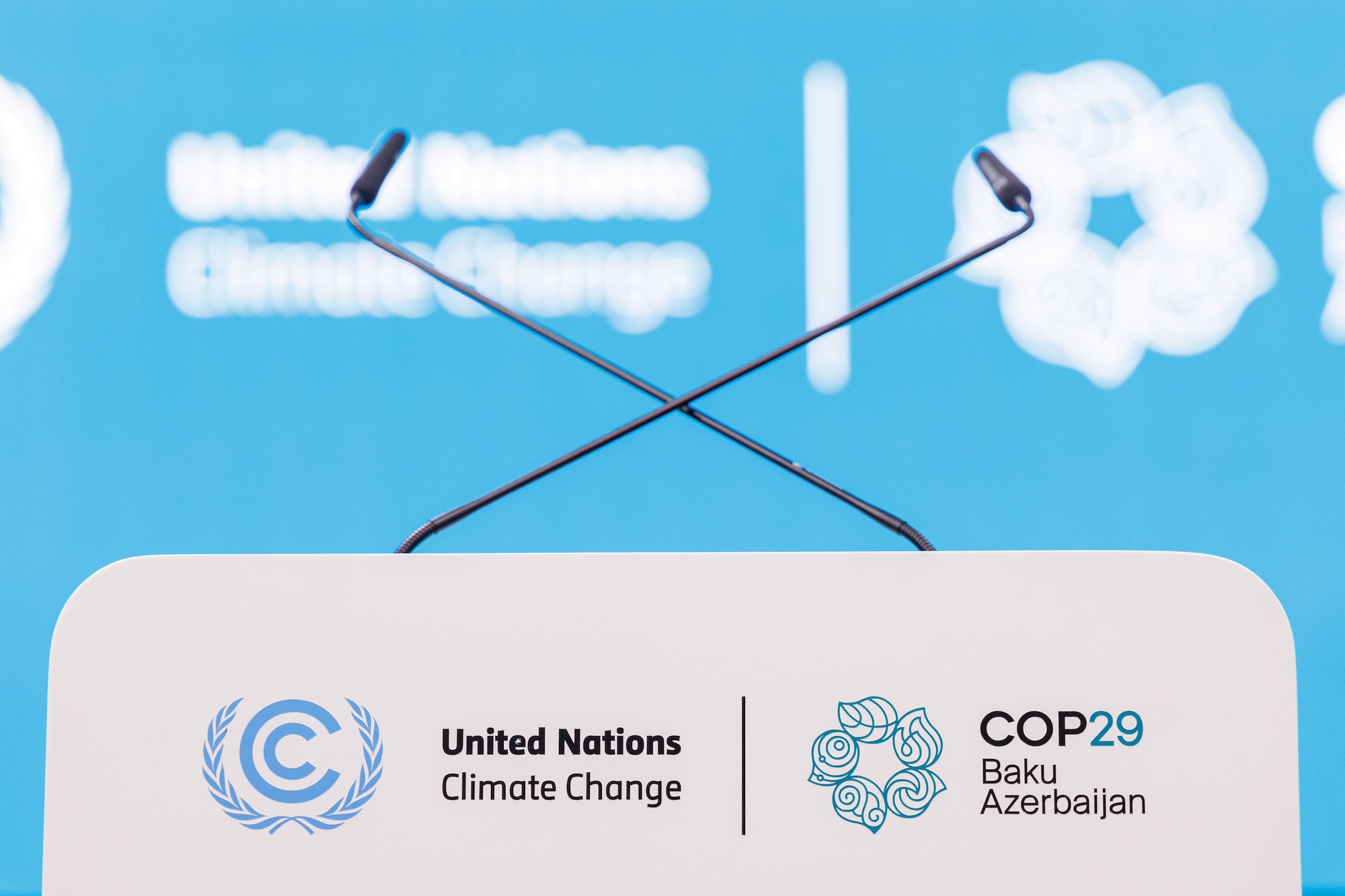Photo credit: COP29
This year’s annual Conference of the Parties — COP29 — took place in Baku, Azerbaijan from November 11 to November 22. COP is a yearly opportunity for participating countries to collaborate, conduct negotiations and address international concerns relating to climate.
More than 65,000 delegates registered to attend, making this the second-largest COP on record, but still significantly smaller than last year’s record-breaking COP28 in Dubai, which saw around 85,000 attendees.
Canada’s delegation was led by Environment and Climate Minister Steven Guilbeault, along with Canada’s Ambassador for Climate Change, Catherine Stewart. Jeanne-Marie Huddleston, Canada’s Chief Negotiator for Climate Change, led Canada’s participation in negotiations.
Here are some of the headlines from this year’s conference:
Global carbon market mechanism
Climate negotiators hit the ground running on day one of COP29, reaching a consensus on a set of standards from Article 6.4 — the Paris Agreement Crediting Mechanism — for a centralized global carbon market.
These standards would allow countries and private sector companies to transfer carbon credits produced through the reduction of greenhouse gas emissions to help other countries achieve their targets.
Once implemented, UN Climate Change Executive Secretary Simon Stiell says the market would help countries implement their climate plans in a “faster and cheaper” manner and reduce emissions.
The World Bank Group estimates that trading carbon credits between countries could reduce the cost of implementing Nationally Determined Contributions — a country’s climate action plan, which outlines how it will reduce emissions — by as much as $250 billion in 2030.
“The breakthrough on Article 6 is a big step towards creating a global carbon market,” says Alma Hadzic, consulting director at Deloitte and Canada Powered by Women board member.
Minister Guilbeault announces GAIA
A key focus of this year’s conference was on finance, and the investment required for countries around the globe to reduce emissions and protect lives and livelihoods from the impacts of climate change.
In 2009, Canada and 22 other high-income countries, including the U.S., Japan and Australia, agreed to mobilize USD$100 billion annually by 2020 to support other countries in their emissions reduction efforts. That goal was met for the first time in 2022 (two years behind schedule) and is set to expire this year.
The new target for climate finance proposed by economists at COP29 is $1 trillion a year by 2030, a figure met with uncertainty following the recent U.S. election, which may result in the country’s withdrawal from any future climate funding.
On the second day of the conference, Minister Guilbeault reaffirmed Canada’s commitment to climate finance when he announced the launch of GAIA, a new USD$1.48 billion blended finance platform that will mobilize climate-focused investments in vulnerable regions.
“Canada came to COP29 ready to secure a new goal and new funding sources for climate finance needed to support developing nations’ efforts to address the causes and impacts of climate change,” says Minister Guilbeault.
The platform, co-funded by FinDev Canada in partnership with Mitsubishi Financial Group with an anchor investment from the Green Climate Fund, will bring together public and private capital to increase the availability of climate finance for high-impact climate action projects in up to 25 emerging markets and developing economies.
Alberta announces early success with methane emissions reduction
Alberta’s Minister of Environment and Protected Areas, Rebecca Schulz, attended the conference in Baku where she shared an update on Alberta’s methane emissions reduction success with the world.
Alberta committed to reducing methane emissions by 45 per cent from 2014 levels by 2025. As of 2023, Alberta has reduced emissions from 2014 levels by 52 per cent, surpassing the provincial goal three years ahead of schedule.
“Alberta is one of the world’s most responsible producers of oil and gas,” Minister Schulz said on X. “Emissions in methane, electricity generation and per barrel emissions intensity in oil and gas are all in decline, without dangerous production caps or costly carbon taxes.
“That’s why we are at COP29. As global demand for safe, affordable, reliable and secure energy continues to rise, Alberta is ready to answer that call and be that responsible producer of choice.”
The minister also announced a $40 million investment from the Technology Innovation and Emissions Reduction (TIER) fund to support Emission Reduction Alberta’s (ERA) Advanced Materials Challenge.
The goal of the initiative is to drive technological advancements and the development of low-emissions products across a range of industries, including plastics, concrete, food, wood, carbon materials and chemicals, ultimately reducing emissions while improving the competitiveness of Alberta’s manufacturing and resource sectors.

Photo credit: COP29
Indigenous-led LNG
The First Nations Climate Initiative (FNCI) is a collective led by Canada’s Haisla, Metlakatla, Nisga’a and Halfway River First Nations to facilitate active collaboration in the fight against climate change and poverty in First Nations’ communities.
Leaders of the FNCI attended the conference to pitch Indigenous-led LNG from projects such as Cedar LNG and Ksi Lisims LNG in British Columbia to potential importers in Asia, including Taiwan, Japan and Korea, as a way to ensure the long-term viability of the projects and help lower global emissions.
“As part of their COP29 calls to action, [Alex] Grzybowski and the FNCI are calling on the federal, British Columbia and Alberta governments to invest and support technologies that would lengthen the shelf-life of natural gas in a low-carbon world,” APTN News reports.
The projects, however, were met with skepticism from critics like John Young, an LNG senior strategist at Climate Action Network, who does not believe LNG has a role in global decarbonization.
According to the FNCI, Indigenous LNG not only has a role to play in decarbonization, but presents a path towards greater inclusion of Indigenous nations in energy projects and economic reconciliation.
“First Nations would become leaders in the economy, not bystanders,” says Grzybowski.
The rising role of nuclear
“Nuclear energy has been a hot topic at the conference,” says Hadzic. “Six more countries joined a pledge to triple nuclear power by 2050 and the U.S. doubled down on its own plan.”
El Salvador, Kazakhstan, Kenya, Kosovo, Nigeria and Turkey now endorse the Declaration to Triple Nuclear Energy, originally signed at COP28 in Dubai last year, bringing the number of signatories to 31.
The declaration, already supported by major players like Canada and the United States, entrenches the role of nuclear in the energy transformation through the use of large-scale reactors and small modular reactors (SMRs).
In Canada, Ontario is currently in the process of scaling up its nuclear capacity to meet the projected increase in demand for electricity, and recently announced the completion of the Darlington Unit 1 refurbishment five months ahead of schedule.
“As COP29 continues, the focus will be on getting more funding for developing nations, improving climate resilience and using tech to drive real change,” says Hadzic. COP29 will come to a close Friday, Nov. 22.
